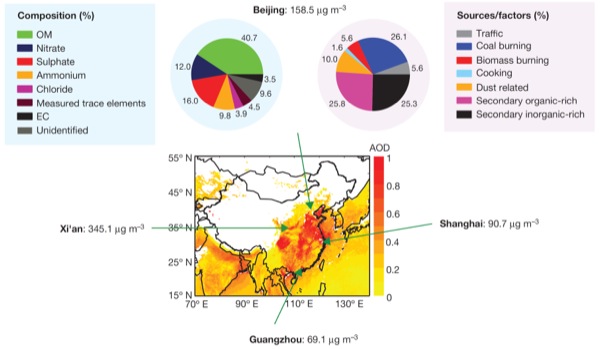|
Within an international collaboration, the group of PD Dr. Sönke Szidat recently contributed to the identification of sources of air-borne fine particulate matter in China during severe pollution episodes in January 2013.
Such events were driven to a large extent by secondary aerosols, which were formed in the atmosphere by oxidation of gaseous precursors, rather than by direct aerosol emissions. The details of this investigation and the role of radiocarbon measurements in this study are published in Nature and Atmos. Chem. Phys. Discuss., see references below.
References:
-
R.-J. Huang, Y. Zhang, C. Bozzetti, K.-F. Ho, J.-J. Cao, Y. Han, K. R. Daellenbach, J. G. Slowik, S. M. Platt, F. Canonaco, P. Zotter, R. Wolf, S. M. Pieber, E. A. Bruns, M. Crippa, G. Ciarelli, A. Piazzalunga, M. Schwikowski, G. Abbaszade, J. Schnelle-Kreis, R. Zimmermann, Z. An, S. Szidat, U. Baltensperger, I. El Haddad, A. S. H. Prévôt;
"High secondary aerosol contribution to particulate pollution during haze events in China"
Nature, 514, 218-222, (2014);
doi:10.1038/nature13774.
-
Y.-L. Zhang, R.-J. Huang, I. El Haddad, K.-F. Ho, J.-J. Cao, Y. Han, P. Zotter, C. Bozzetti, K. R. Daellenbach, F. Canonaco, J. G. Slowik, G. Salazar, M. Schwikowski, J. Schnelle-Kreis, G. Abbaszade, R. Zimmermann, U. Baltensperger, A. S. H. Prévôt, S. Szidat;
"Fossil vs. non-fossil sources of fine carbonaceous aerosols in four Chinese cities during the extreme winter haze episode in 2013"
Atmos. Chem. Phys. Discuss., 14, 26257-26296, (2014);
doi:10.5194/acpd-14-26257-2014.
|
